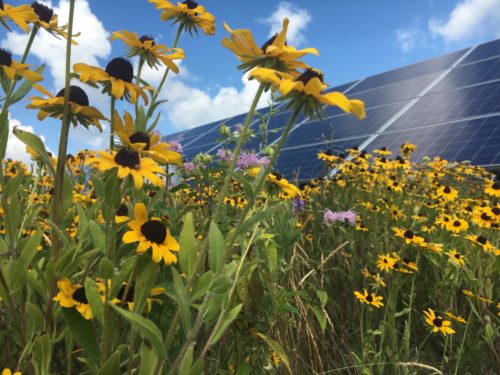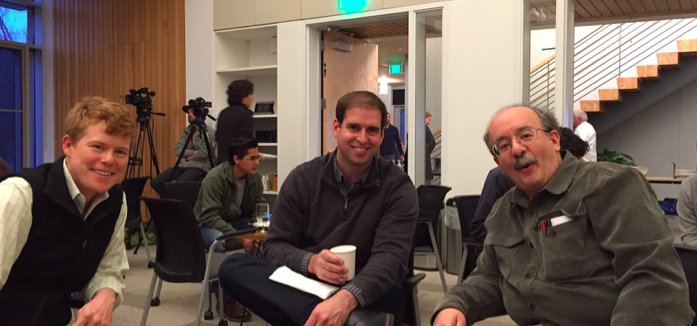
Amory Lovins’s Extreme Energy Efficiency: Stanford Students Learn the Future of Design
“Learning that only 0.5 percent of the fuel consumed by a vehicle is used to move the driver completely shifted the way I view transportation,” wrote Lance Yupingkun, one of 39 Stanford University students (pictured above) who attended a weeklong Rocky Mountain Institute class on integrative design and extreme energy efficiency. Held at the end of March, the class was conceived and cosponsored by RMI, the Straubel Family Foundation, and Stanford Energy professor Jane Woodward. Amory Lovins and the Office of the Chief Scientist team hosted the group at the Innovation Center in Basalt, Colorado. Students spent a week learning and practicing how to increase efficiency though design within the buildings, mobility, industrial, and electricity sectors.
The class toured Amory’s net-zero energy home in Old Snowmass and heard from several industry leaders from outside of RMI about their experiences applying whole-systems thinking in their work. On the opening night of the course, Tesla cofounder and CTO JB Straubel shared a few examples of how integrative design has played a role in designing electric vehicles like the Tesla Model S. The course wrapped up with a talk by Holmes Hummel—founder of Clean Energy Works, board director of Cornerstone Capital, and a teaching assistant for the course—about her journey through the world of energy policy, finance, and technology.

Undergraduate and graduate students from various academic and professional backgrounds attended the class, with many studying engineering, and a number studying law, business, and other disciplines. This diverse mix made for an engaging and dynamic environment in which the students, RMI staff, and Stanford teaching assistants all had much to learn from one another. The week was filled with lively discussions around the roles of policy, business, and technology in the energy and efficiency transition, with each participant contributing a unique perspective based on his or her varied experiences.
“Taking Jane Woodward’s Energy Resources class as a freshman at Stanford was a pivotal moment in my life,” said Straubel. “Part of the reason my wife, Boryana, and I started the Straubel Family Foundation was to help expose young people to great thinkers like Jane and Amory. This was even better than we’d hoped, and Amory and the RMI staff were fantastic.”
What is Integrative Design?
Integrative design reveals and exploits connections between parts of a system to achieve far more than the sum of their individual benefits. Integrative designers optimize the performance of buildings, vehicles, machines, and industrial processes by collaborating in diverse teams to understand how the parts work together as a system, and then use this knowledge to harness synergies that increase efficiency, reduce waste and energy use, and improve functionality. Rather than saving more energy by using more, costlier technologies, integrative design uses and artfully combines fewer, simpler technologies, achieving greater savings at lower cost and creating expanding returns rather than diminishing returns.
Some leading companies and industries are already using integrative design to achieve radical resource efficiency. For example, Interface, Inc. applied integrative design principles to its Dutch carpet factory. More-efficient pumps and motors were obvious energy-efficiency measures. But integrative design achieved far greater savings by expanding the system boundaries and making pipes fat, short, and straight. This design solution cut pipe friction by at least 86 percent, shrinking the pumps and motors, and cutting both capital and operating costs.
Over the past few decades, RMI cofounder Amory Lovins and his colleagues have developed a unique suite of design techniques and principles that apply whole-systems thinking to achieve extreme—even order-of-magnitude higher—energy and resource efficiency. This approach has yielded enormous energy savings, better performance, and lower capital cost across diverse engineering disciplines and applications.
During the integrative design course at RMI in March, Stanford students had the opportunity to learn about these design principles and practice applying them to real-world systems during daily problem-solving sessions. Some of the exercises included redesigning the world’s cement system to emit roughly no CO2, optimizing Walmart’s freight logistics, and rethinking the world’s industrial forestry system to deliver the same services but with far less harvest of natural forests. Students were encouraged to approach these problems by thinking about the end goal of the system first—by addressing and minimizing downstream needs, upstream requirements can be better optimized and often reduced. One of the students, Lance Yupingkun, provides his perspective below.
Working Toward a Better Tomorrow—Lance Yupingkun
Understanding the main objective of a system or technology, often tied to the end user, is key to unlocking pathways that can more effectively reduce energy intensity. In the case of transportation, for example, the end goal is to move the driver of a vehicle, not the vehicle itself—which then opens up the solution space to include public transportation, ridesharing, and urban design, among other things. This draws our attention away from efforts that only render incremental benefits (e.g., increasing powertrain efficiency). As the course moved through the sectors that consume the majority of the world’s energy (mobility, industry, buildings, and electricity), it clearly showed how focusing on and truly understanding the demand first can ultimately bring about a clean, prosperous, and secure future.
The class also provided a space for us to reflect on the roles we can play in this future. On the fifth day, I went strolling by the river with two other students, Jake and Justin. While we shared in each other’s excitement over the potential of a better tomorrow, we also felt overwhelmed by the complexity of the challenges along the way. There seemed to be so many of them that it was hard to identify where to start.
Later that afternoon, we participated in an activity called Re-Zoom. Each person starts with a picture on a card, and only that person knows what is on that card. The cards, put together in the correct order, tell a complete story. The objective is for each person to find relationships with two other cards through conversations with others without showing them the card. At the end of the activity, the class was able to complete the whole story from the cards without one major driver. Everyone started by focusing on his or her own card, sought others who had cards that were relevant, and then helped others find their matches, so that ultimately the entire group solved the puzzle together from the ground up.
One can’t help but draw parallels between the Re-Zooom activity and bringing about the ideal energy future. By focusing on our own pieces while being mindful of the interdependencies of our work with others, we may ultimately find confluence in our efforts toward a better tomorrow.
The Office of the Chief Scientist team would like to thank the Stanford teaching assistants, the Straubel Foundation, and Jane Woodward for making this course happen. We also thank all the students involved for their creativity, enthusiasm, and engagement during the course.
